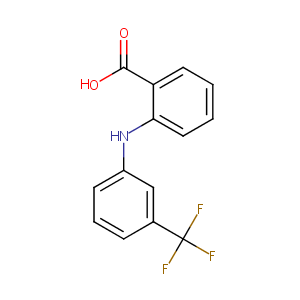Drug Information
| Drug General Information | Top | |||
|---|---|---|---|---|
| Drug ID |
D0B2WJ
|
|||
| Former ID |
DNC002446
|
|||
| Drug Name |
Flufenamic Acid
|
|||
| Synonyms |
flufenamic acid; 530-78-9; Fluphenamic acid; Nichisedan; Achless; Arlef; Tecramine; Paraflu; Lanceat; Flufacid; Plostene; Fullsafe; Parlef; Surika; Parlif; Flufenaminsaeure; Reumajust A; Acido flufenamico; N-(3-Trifluoromethylphenyl)anthranilic acid; Ristogen; Sastridex; Meralen; Ansatin; 2-((3-(Trifluoromethyl)phenyl)amino)benzoic acid; Fluore-200; 2-{[3-(trifluoromethyl)phenyl]amino}benzoic acid; ANT-1; Acide flufenamique; Acidum flufenamicum; TVX 916; INF 1837; 3'-Trifluoromethyldiphenylamine-2-carboxylic acid; NSC-82699; CI 440
Click to Show/Hide
|
|||
| Drug Type |
Small molecular drug
|
|||
| Indication | Dysmenorrhea [ICD-11: GA34.3; ICD-9: 625.3] | Approved | [1], [2] | |
| Structure |
 |
Download2D MOL |
||
| Formula |
C14H10F3NO2
|
|||
| Canonical SMILES |
C1=CC=C(C(=C1)C(=O)O)NC2=CC=CC(=C2)C(F)(F)F
|
|||
| InChI |
1S/C14H10F3NO2/c15-14(16,17)9-4-3-5-10(8-9)18-12-7-2-1-6-11(12)13(19)20/h1-8,18H,(H,19,20)
|
|||
| InChIKey |
LPEPZBJOKDYZAD-UHFFFAOYSA-N
|
|||
| CAS Number |
CAS 530-78-9
|
|||
| PubChem Compound ID | ||||
| PubChem Substance ID |
121213, 129884, 583427, 825185, 832225, 855855, 3136545, 3296204, 5329923, 7848644, 7887502, 7979236, 8149699, 8152145, 10321320, 10525534, 11112395, 11119923, 11120411, 11120899, 11121384, 11121864, 11141586, 11147006, 11335756, 11360995, 11362453, 11364151, 11364681, 11365015, 11366713, 11367243, 11367577, 11369275, 11369805, 11370177, 11370178, 11372465, 11372846, 11373178, 11373563, 11375405, 11375739, 11377437, 11377968, 11461967, 11466231, 11467351, 11484634, 11485842
|
|||
| ChEBI ID |
CHEBI:42638
|
|||
| SuperDrug ATC ID |
M01AG03
|
|||
| Interaction between the Drug and Microbe | Top | |||
|---|---|---|---|---|
| The Abundace of Studied Microbe(s) Regulated by Drug | ||||
| The Order in the Taxonomic Hierarchy of the following Microbe(s): Bacteroidales | ||||
|
Studied Microbe: Bacteroides ovatus
Show/Hide Hierarchy
|
[3] | |||
| Hierarchy | ||||
| Abundance Change | Decrease | |||
| Experiment Method | High-throughput screening | |||
| Description | The abundance of Bacteroides ovatus was decreased by Flufenamic acid (adjusted p-values: 6.01E-04). | |||
|
Studied Microbe: Odoribacter splanchnicus
Show/Hide Hierarchy
|
[3] | |||
| Hierarchy | ||||
| Abundance Change | Decrease | |||
| Experiment Method | High-throughput screening | |||
| Description | The abundance of Odoribacter splanchnicus was decreased by Flufenamic acid (adjusted p-values: 4.84E-03). | |||
|
Studied Microbe: Parabacteroides distasonis
Show/Hide Hierarchy
|
[3] | |||
| Hierarchy | ||||
| Abundance Change | Decrease | |||
| Experiment Method | High-throughput screening | |||
| Description | The abundance of Parabacteroides distasonis was decreased by Flufenamic acid (adjusted p-values: 1.15E-03). | |||
|
Studied Microbe: Parabacteroides merdae
Show/Hide Hierarchy
|
[3] | |||
| Hierarchy | ||||
| Abundance Change | Decrease | |||
| Experiment Method | High-throughput screening | |||
| Description | The abundance of Parabacteroides merdae was decreased by Flufenamic acid (adjusted p-values: 8.82E-03). | |||
| References | Top | |||
|---|---|---|---|---|
| REF 1 | URL: http://www.guidetopharmacology.org Nucleic Acids Res. 2015 Oct 12. pii: gkv1037. The IUPHAR/BPS Guide to PHARMACOLOGY in 2016: towards curated quantitative interactions between 1300 protein targets and 6000 ligands. (Ligand id: 2447). | |||
| REF 2 | Drugs@FDA. U.S. Food and Drug Administration. U.S. Department of Health & Human Services. 2015 | |||
| REF 3 | Extensive impact of non-antibiotic drugs on human gut bacteria. Nature. 2018 Mar 29;555(7698):623-628. | |||
| REF 4 | Ouellet M, Percival MD: Effect of inhibitor time-dependency on selectivity towards cyclooxygenase isoforms. Biochem J. 1995 Feb 15;306 ( Pt 1):247-51. | |||
If You Find Any Error in Data or Bug in Web Service, Please Kindly Report It to Dr. Zhou and Dr. Zhang.

